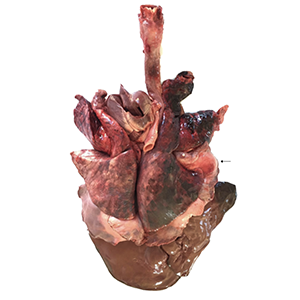Intradiaphragmatic abscesses in a wild boar (Sus scrofa): Inspective implications based on anatomopathological evidences

Accepted: 11 April 2022
HTML: 9
All claims expressed in this article are solely those of the authors and do not necessarily represent those of their affiliated organizations, or those of the publisher, the editors and the reviewers. Any product that may be evaluated in this article or claim that may be made by its manufacturer is not guaranteed or endorsed by the publisher.
The intradiaphragmatic localization of an abscess is rarely described in humans and in other animal domestic and wild species, and can be caused by penetrative traumas (i.e., firearm injuries). Here we describe two intradiaphragmatic abscesses in a hunted adult male wild boar (Sus scrofa) pluck, associated with adhesion phenomena with the contiguous anatomical structures (pleural, phrenic, and glissonian serosas) and observed during the post mortem inspection, in accordance with the Reg. EU 627/2019. One of these lesions also presented a phreno-abdominal fistula. We found in cytopathological evaluation of the neoformations’ content the presence of spheroidal bacterial soma, characterized by linearly concatenated “Streptococcus-like” aggregation pattern. Furthermore, microbiological assays revealed a polymicrobial pattern characterized by the presence of telluric microorganisms, some of which have a marked pyogenic action (Streptococcus suis type I, Sphingomonas paucimobilis, Carnobacterium divergens, and Lactobacillus sakei). Our results and collected evidence demonstrate the pathogenetic hypothesis of bacterial contamination secondary to penetrative trauma caused by a not-mortal projectile’s wound, defining the inspective behaviour according to the cogent legislation. These lesions, in the reason of their potential relation to toxemia, bacteremia and septicemia phenomena, represent a sanitary risk that impose, from a normative point of view, the total condemnation of the carcass. These inspective implications, originating from the observation and interdisciplinary description of the anatomopathological and microbiological features of the lesions, are directly projected on the normative scenario, providing useful elements to guarantee the health of the consumer.
Chaillou S, Champomier-Vergès MC, Cornet M, Crutz-Le Coq AM, Dudez AM, Martin V, Beaufils S, Darbon-Rongère E, Bossy R, Loux V, Zagorec M, 2005. The complete genome sequence of the meat-borne lactic acid bacterium Lactobacillus sakei 23K. Nat Biotechnol 23:1527-33. DOI: https://doi.org/10.1038/nbt1160
Heaver SL, Johnson EL, Ley RE, 2018. Sphingolipids in host-microbial interactions. Curr Opin Microbiol 43:92-9. DOI: https://doi.org/10.1016/j.mib.2017.12.011
Heung LJ, Luberto C, Del Poeta M, 2006. Role of sphingolipids in microbial pathogenesis. Infect Immun 74:28-39. DOI: https://doi.org/10.1128/IAI.74.1.28-39.2006
Kumar V, Abbas A, Aster J, 2014. Robbins & Cotran pathologic basis of disease. 9th ed. Elsevier.
Mercer CD, Hill LD, 1985. Intradiaphragmatic abscess. An extremely rare complication of pneumatic dilatation of the esophagus. Dig Dis Sci 30:891-5. DOI: https://doi.org/10.1007/BF01309521
Murase K, Watanabe T, Arai S, Kim H, Tohya M, Ishida-Kuroki K, Võ TH, Nguyễn T, Nakagawa I, Osawa R, Nguyễn NH, Sekizaki T, 2019. Characterization of pig saliva as the major natural habitat of Streptococcus suis by analyzing oral, fecal, vaginal, and environmental microbiota. PLoS One 14:e0215983. DOI: https://doi.org/10.1371/journal.pone.0215983
Rieder G, Krisch L, Fischer H, Kaufmann M, Maringer A, Wessler S, 2012. Carnobacterium divergens - a dominating bacterium of pork meat juice. FEMS Microbiol Lett 332:122-30. DOI: https://doi.org/10.1111/j.1574-6968.2012.02584.x
Thomas CJ, Schroder K, 2013. Pattern recognition receptor function in neutrophils. Trends Immunol 34:317-28. DOI: https://doi.org/10.1016/j.it.2013.02.008
PAGEPress has chosen to apply the Creative Commons Attribution NonCommercial 4.0 International License (CC BY-NC 4.0) to all manuscripts to be published.


 https://doi.org/10.4081/ijfs.2022.10346
https://doi.org/10.4081/ijfs.2022.10346



